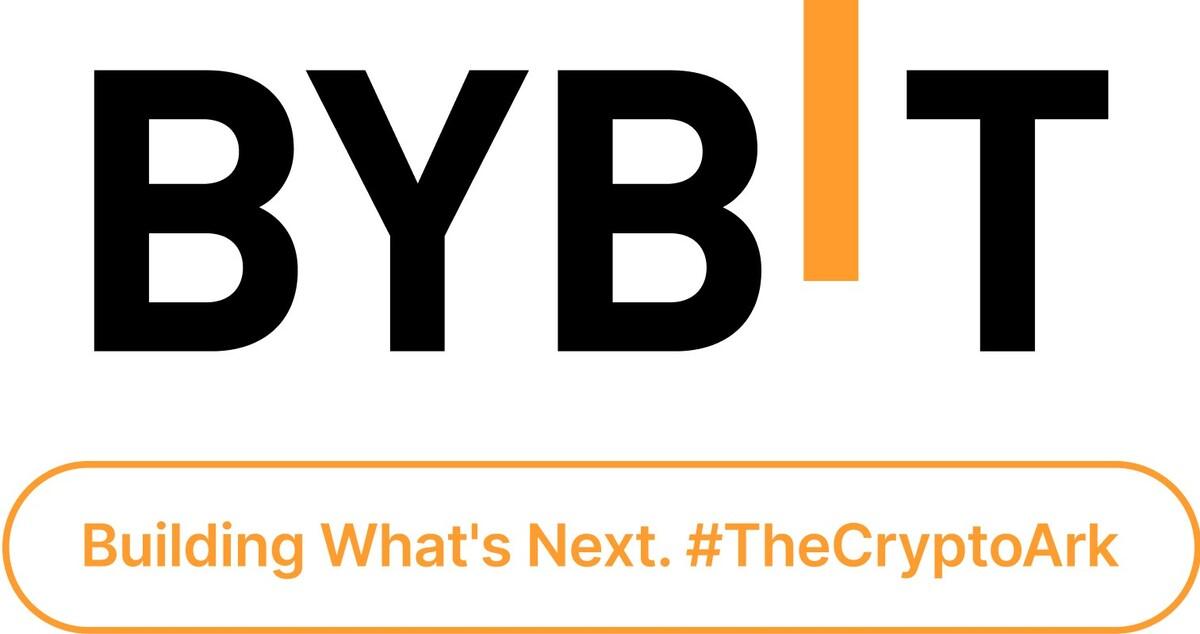Rocket Pool is the first Ethereum Proof of Stake (PoS) infrastructure service designed to be highly decentralized, distributed, and compatible with staking in Ethereum 2.0. This platform is currently ranked 3rd in the Liquid staking TVL Rankings with TVL $1.41b. If you are curious about this protocol, this Rocket Pool review is for you.
About Rocket Pool
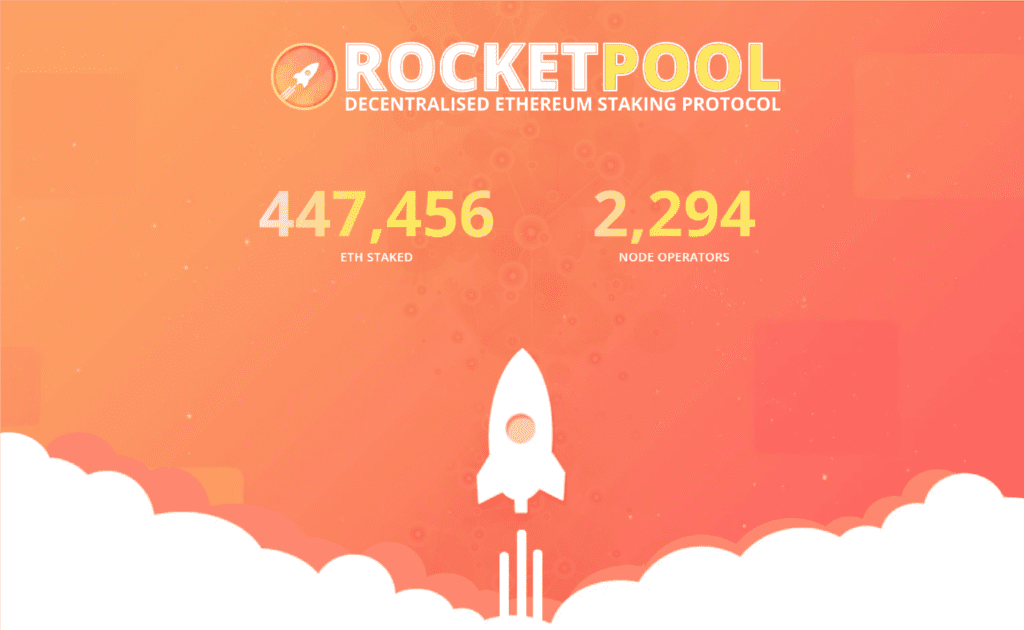
Rocket Pool is a decentralized Ethereum 2.0 staking pool that uses liquid staking technology and smart contracts to make it easy for users to earn rewards by participating in the Ethereum 2.0 network. It uses a liquid staking token that accumulates value using an ever-increasing exchange rate and features open-source, audited smart contracts to ensure node operators never manage funds. The platform also allows any user, business, or team to run a node and stake their own ETH for free to generate higher returns. The platform minimizes the risk of penalties and focuses on redundancy and network decentralization to mitigate potential issues.
On other staking pools, to become a validator on the Ethereum network and start earning staking rewards, users must stake at least 32 ETH and need a good CPU (Intel i5-760 or higher). This is where the community-owned Rocket Pool staking protocol comes in handy, as it allows users to stake ETH 2.0 in a trustless way with lower requirements.
Rocket Pool was founded in 2016 by David Rugendyke, a senior developer with over 18 years of experience in the commercial sector. Today, it is one of the most popular platforms of its kind. The Oracle DAO consists of members who are significant players in the ETH 2.0 staking field, such as Lighthouse, Bankless, Blockchain Capital, Staked, Consensys, Nimbus, Codefi, and others.
Oracle DAO (Decentralized Autonomous Organization) consists of node operators in Rocket Pool that run Oracle nodes. In addition to validating transactions on the Ethereum network like regular nodes, oracles have additional oracle tasks, such as validating oracle data sent to the protocol and reporting the balance of the oracle Beacon string validation.
With the growing demand for ETH 2.0 staking services from the crypto community, Rocket Pool has become one of the largest ETH 2.0 staking pools, with over 447,456 ETH staked and over 1800 miners node mining around the world.
How does Rocket Pool work?
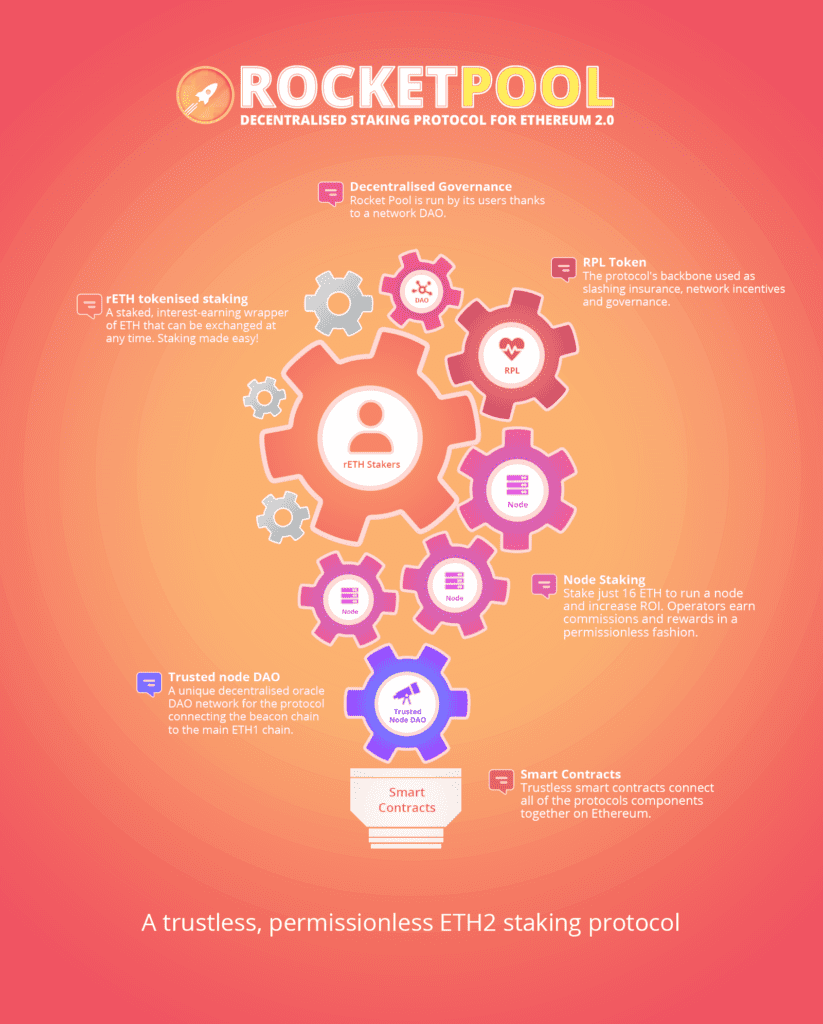
Rocket Pool allows users to stake ETH and earn staking rewards by becoming a node operator, requiring a deposit of 16 ETH or using rETH, its liquidity token, with minimal requirements of 0.01 ETH. Node operators are also required to deposit a minimum equivalent of 1.6 ETH in RPL tokens as collateral in the event of a penalty. Their staking balance drops below 16 ETH (guaranteed).
Given that a minimum of 32 ETH is required to stake Ethereum as a node operator and you only need 16 ETH on Rocket Pool, the remaining 16 ETH is allocated by protocol from the deposits of regular stakingers. These people receive rETH for their ETH.
Notably, the 16 additional ETH tokens specified by the protocol will also generate a commission reward. As a node operator, you will also get paid for staking ETH of the network. Rocket Pool’s commission rate is based on the supply and demand of ether on the platform, increasing or decreasing depending on the number of node operators available.
Types of Staking on Rocket Pool
Via Rocket Pool directly
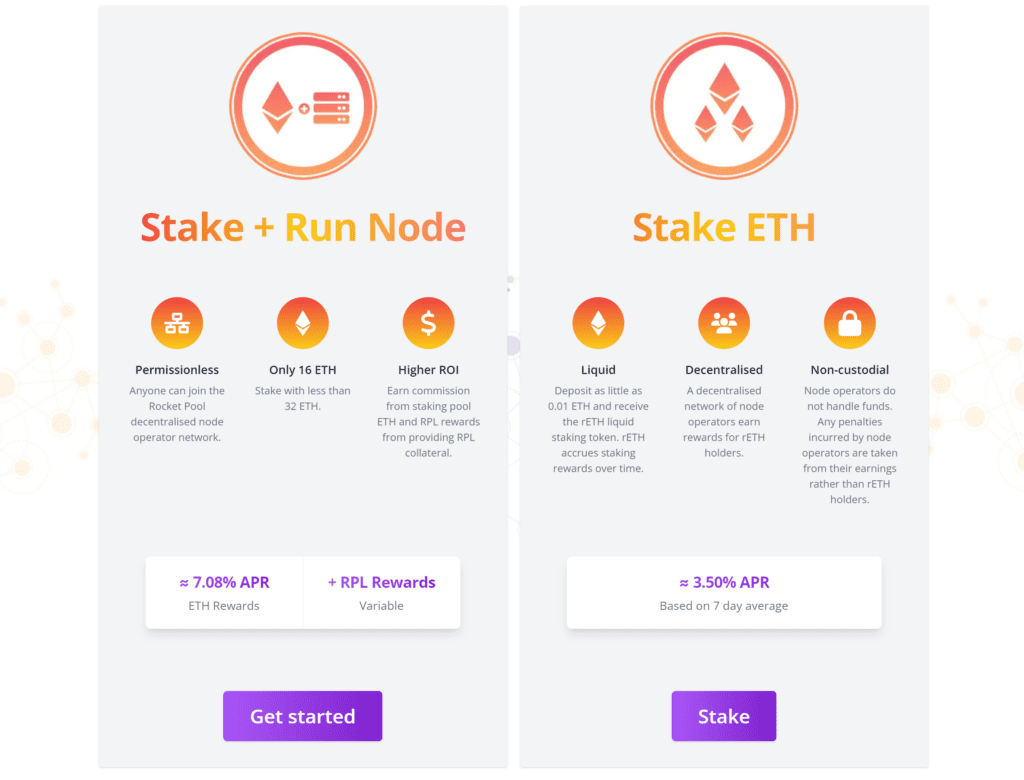
Liquid staking with rETH token tokenization
In exchange for depositing ETH into Rocket Pool, users will receive rETH. rETH is fully composable within the broader DeFi landscape while accumulating value from ETH earned through staking.
Sending ETH and receiving rETH can be done in a single transaction by many different groups of users, be it individuals, dApps, exchanges, wallets, or anyone who wants to use the protocol or build on top of it. This is an easy and permissionless way to join staking without running any staking infrastructure or even needing 32 ETH. With Rocket Pool, you can bet as little as 0 0.01 ETH this way.
When you stake ETH and receive rETH, it automatically starts accumulating staking rewards based on the performance of the entire decentralized network of active node operators in Rocket Pool. This means that rETH increases in value over time, while holders can use that collateral to take advantage of the broader DeFi landscape while helping to secure the Ethereum network.
The value of rETH is protected from node reduction and downtime by some built-in insurance mechanism, with node operators staking RPL on nodes as collateral for any punishment they incur. More detail on these mechanisms will be available in Part 3 of this series, RPL & Tokenomics.
If you have rETH, you can also exchange it back to Rocket Pool for ETH plus rewards at any time if the liquidity in the deposit pool is sufficient to cover this amount. Or swap on any supported decentralized provider such as 1 inch at prevailing market prices – no need to wait several years to withdraw liquid Ethereum or claim your staking rewards.
Node Staking
From hobbyist node operators to full-blown SaaS specialists, Rocket Pool allows you to earn a more significant ROI on staking inside the protocol than outside of it.
If you want to run a node in Rocket Pool, you will not be charged any fees because you provide a valuable service to the protocol. With the protocol, running a node only requires a minimum of 16 ETH per validator compared to 32 ETH outside the protocol.
After you send 16 ETH, the protocol assigns you 16 ETH from users who are sending ETH and receiving rETH. So, as a node operator, you are staking your own 16 ETH and 16 ETH on behalf of the protocol.
Rocket Pool has a fixed commission rate of 15%, allowing the node operator to earn a percentage of the rewards earned on those 16 ETH specified by the protocol. This means that node operators earn rewards from their own 16 ETH deposits plus commissions from the network for staking ETH. The protocol is designed to reward node operators for providing valuable insurance if they are hit with a hefty fine or slash.
When depositing ETH, node operators must also deposit a minimum amount of RPL as collateral if they incur any of these penalties. If a penalty occurs and the user ends up staking with <16 ETH, the collateral will be sold for ETH in the auction, and the proceeds from this sale will be returned to the protocol to compensate for the missing ETH.
When a node operator offers an amount of RPL as collateral as an insurance promise, they are rewarded with RPL rewards in proportion to the amount of collateral they provide. The minimum required collateral is currently 10% of the node operator’s ETH value and is capped at 150%.
Via Ethereum Decentralized Exchange (Layer 1)

With this method, you will go to a decentralized exchange like Balancer (opens new window) or Uniswap (opens new window) and buy rETH with a token of your choice, just like any other token swap.
Rocket Pool has officially created a stable pool that can be combined with Balancer (opens new window). The composable stable pool is ideal for tokens like rETH, as they respect the real exchange rate reported by the Oracle DAO – this means trading with it will have lower slippage and fees much more than regular decentralized exchanges, so you will get more incentives when buying or selling rETH.
Because of this and since it has a smaller transaction fee than a direct swap via Rocket Pool’s website, you should use a Balancer if you want to bet via this route.
If Balancer is not for you, there is also an ETH-rETH liquidity pool on Uniswap. Note that this is a regular pool, so you will suffer from slippage and higher fees if you use it, but gas fees will still be lower than staking directly through the Rocket Pool website.
Via Decentralized Exchange on Layer 2 Network

With this method, you would start by connecting your existing ETH (or other tokens of choice) to the Ethereum Layer 2 network, such as Optimism (opens new window) or arbitrator (opens new window) and then use a decentralized exchange on the network to buy rETH. This method is attractive if you already have tokens on the Layer 2 network because the transaction fees are ~10 times smaller than on the Ethereum mainnet. However, if this is your first time using a Layer 2 network, you must take a few extra steps to set it up.
RPL And rETH Tokens
The Rocket Pool protocol uses two tokens, RPL (administrative, insurance, and utility token) and rETH, a staking liquidity token pegged to ether, representing ETH staked bet plus rewards earned by staking.
RPL can be traded on major crypto exchanges, decentralized (Uniswap V3) and centralized (Kraken, BKEX, CoinW). rETH is available on Balancer V2, Uniswap V3, or Curve Finance and can be redeemed back to the original ETH at any time or used for Defi activities such as lending.

RPL tokens are used as governance tokens for the Rocket Pool protocol, which can also be staked on a node as insurance for additional rewards. When setting up an operating node, in addition to the 16 ETH required, the equivalent of 10% of that ETH in the form of RPL tokens is also needed.
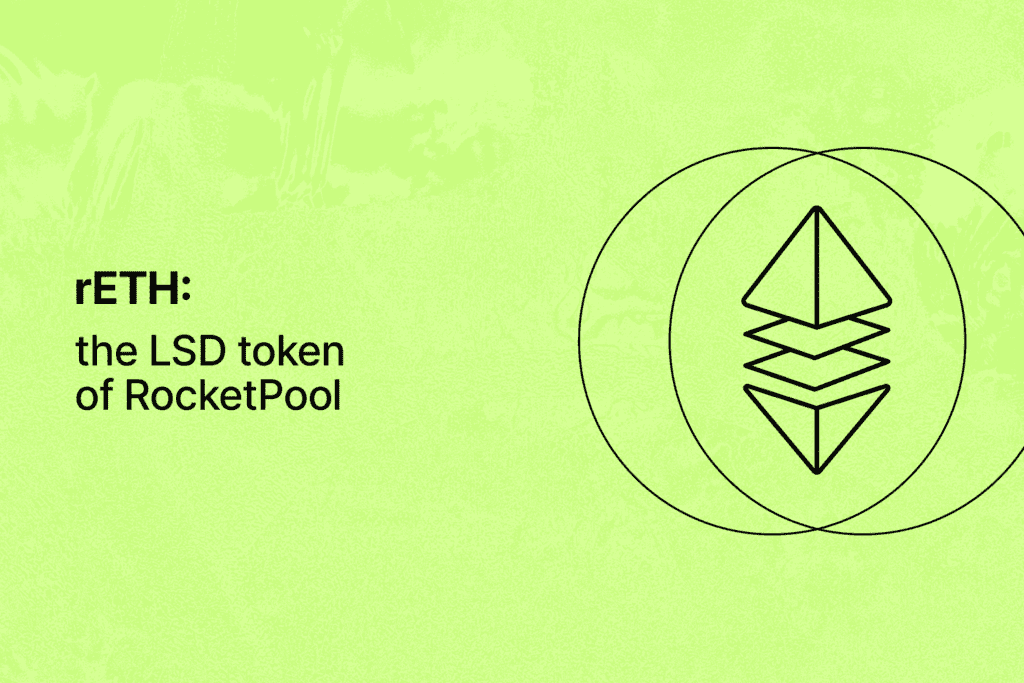
rETH is an ERC-20 token that works similarly to Wrapped Ethereum and can be used like any other ERC-20 token. You can lend, use as collateral, or trade. You can also exchange rETH back to ETH by burning it. However, that is only possible if the pool has enough original ETH at that time, which means in some cases, you may have to wait until ETH is available.
Rocket Pool rewards
Rocket Pool rewards or RPL tokens are minted over a 28-day period. You do not need to claim your rewards on a specific date. Instead, they accumulate in your balance and can be wagered for additional rewards or claims at any point in time. RPL tokens are automatically sent to your ETH address and can be swapped, used as collateral, or traded for other cryptocurrencies.
As a normal ETH 2.0 bettor not running a node, your rETH balance will reflect the rewards earned for staking your ETH. You can cancel your bet or convert your accumulated rETH to original ETH after a waiting period of 24 hours for security reasons.
Conclusion – Rocket Pool Review
Above is our introduction to one of the market’s leading safe and reputable ETH staking protocols. Overall, Rocket Pool makes it possible for most of the public to stake ETH by reducing the minimum amount required to start staking to 0.01 ETH. Staking platforms using permissionless smart contracts allow anyone to become a node operator, from a regular user to a SaaS (Software as a Service) provider. The Rocket Pool protocol is community-owned and decentralized, with critical decisions being made through fair voting.
ETH staking is a service that helps users earn profits and attractive rewards in the market. In particular, after the success of Ethereum’s substantial Shanghai upgrade, staking protocols such as Rocket Pool are increasingly used.
DISCLAIMER: The Information on this website is provided as general market commentary and does not constitute investment advice. We encourage you to do your own research before investing.
Join us to keep track of news: https://linktr.ee/coincu
Foxy
Coincu News





















